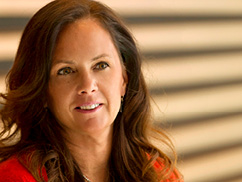I recently had the pleasure of interviewing Jane Alexander, Chief Digital Information Officer of the Cleveland Museum of Art. You may know the CMA from its renowned and innovative digital projects both on-site and online. Some of the most well-known are Artlens, and Open Access, both of which create ways to make the museum’s catalog more accessible. In her role, Jane leads these digital projects along with many others as they go through the planning process, implementation, and their different iterations. She has been working with the museum since 2010, helping to build a reputation for its groundbreaking innovations. Before joining the Cleveland Museum of Art, she had already worked on several major technology projects being the technology director and design consultant for Gehry’s Peter B. Lewis building at Case Western Reserve University, Virtual CIO of Great Lakes Science Center, and director of Columbia University’s distance learning program. Obviously, she knows her stuff.
Early in our conversation, it became clear that Jane is truly passionate about her work, and the Cleveland Museum of Art has the staff, structure, and mission to support strong and innovative digital initiatives. In our conversation, she explained to me some of the elements involved in how the CMA implements its successful technology projects. With iterating being a high priority, evaluation plays an important role. Early on they had no standards or best practices set in place so they set out to create this. Having an evaluation process helps them to make data-based decisions as they are a data-driven organization.
Another important asset to the Cleveland Museum of Art is its robust back-end systems that everything pulls from. This is their point of reference and their “one source of truth” as she calls it, which updates every fifteen minutes making sure that everyone has the same information and knows what is being used and where as well. Much like the constant communication of up-to-date information from the back-end systems, Jane mentions how important collaboration and interdepartmental communication is. There can be difficulties to this but after years of practice, the Cleveland Museum of Art has developed a cross-departmental team helping to keep everyone on the same page, understand different needs to be addressed, and figure out how they can all work towards those solutions. With everything going online this past year, the Cleveland Museum of Art already had that culture of collaboration and communication in place, preparing them for the transition.
As we know, some people can be hesitant to involve digital projects in museums, it is a common fear that they will act as a distraction but when done well like the Cleveland Museum of Art has been doing, it can act as a tool for making art more accessible. I asked Jane how she helps to alleviate anxieties around digital projects and she has found that transparency about the process and getting people involved in it is important. This echoes the earlier message around the importance of communication and collaboration.
To demonstrate the Cleveland Museum of Art’s use of iterations and moving past discomfort with change, Jane described a situation with Studio Play, a creative space that was not meeting its initial goals. While people were hesitant about the iteration, it was an opportunity to assess and improve. The next iteration was designed to encourage more engagement which ended up successfully getting people involved and interested in the rest of the gallery as well. Constantly bringing change and working to improve will create discomfort, certainly, but Jane highlights this as a way to bring different perspectives to the table and further improve the project rather than an obstacle.
Our conversation wraps up reviewing the important concepts we had discussed and hitting on a few last notes, as she recommended an open-access collection, and mentioned how crucial the Cleveland Museum of Art’s support staff is. They are able to make sure everything is running smoothly, and they are the ones that see how visitors interact with the technology giving them valuable insight. It seems that an important element in digital projects is surprisingly human, having an organization where multiple departments collaborate and work towards common goals. I look forward to putting her expertise into motion in my own work as I evaluate, iterate, and collaborate!
